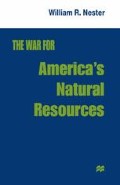Abstract
When Jefferson penned those words, nearly nine out of ten Americans raised crops and livestock and hunted for their sustenance. Two centuries later, America is no more the land of yeoman farmers that Jefferson celebrated. Farming and ranching have experienced technological and productivity revolutions, plummeting the percentage of Americans in those pursuits to less than 2 percent of the population. American agribusiness is the world’s most productive — so productive that the excess is either exported or stored in huge warehouses. Yet despite these revolutionary changes, the raising of crops and livestock has become peripheral to America’s economy, accounting for a mere 3 percent of all economic activity.
Those who labor in the earth are the chosen people of God, if ever he had a chosen people, whose breasts he has made his peculiar deposit for substantial and genuine virtue.
Thomas Jefferson, “Notes on Virginia”
Access this chapter
Tax calculation will be finalised at checkout
Purchases are for personal use only
Preview
Unable to display preview. Download preview PDF.
Notes
Unless otherwise indicated, statistics in this section come from Nancy A. Blanpied, Farm Policy: The Politics of Soil, Surpluses, and Subsidies (Washington, DC: Congressional Quarterly, 1984).
New Farms Represent a Lifestyle, Omaha World Herald August 23, 1992. Willard W. Cochrane and C. Ford Runge, Reforming Farm Policy: Toward a National Agenda (Ames: Iowa State University Press, 1992), p. 4.
Pierre Crosson, “Cropland and Soils: Past Performance and Policy Changes,” in Kenneth Frederick and Roger Sedjo (eds), America’s Renewable Resources. Historical Trends and Current Challenges (Washington, DC: Resources for the Future, 1991), p. 174. Blanpied, Farm Policy p. 105.
Kenneth D. Frederick and Roger A. Sedjo, “Overview: Renewable Resource Trends,” in Frederick and Sedjo (eds), America’s Renewable Resources: Historical Trends and Current Challenges (Washington, DC: Resources for the Future, 1991), pp. 9, 13.
Bernard Shanks, This Land Is Your Land (San Francisco: Sierra Club Books, 1984), p. 75.
Hugh Hammond Bennett, Soil Conservation (New York: McGraw-Hill, 1939), p. 13.
Keith Schneider, “The Farm Economy is Fine and Can Expect More Aid,” New York Times, February 4, 1990.
Ronald Smothers, “U.S. Shutting 1,274 Farm Field Offices,” New York Times, December 7, 1994.
Douglas Frantz, “Reports Describe Widespread Abuse in Farm Program,” New York Times, October 3, 1994.
Steven Holmes, “Fewest U.S. Farms since 1850,” New York Times, November 9, 1994.
Philip Hilts, “Substance Abuse is Blamed for 500,000 Deaths,” New York Times, October 24, 1993;
Philip Hilts, “Children of Smoking Mothers Show Carcinogens in Blood,” New York Times, September 24, 1994;
Shirley J. Hansen, Managing Indoor Air Quality (Lilburn, GA: Fairmont Press, 1991), p. 6;
US Public Health Service, “The Health Consequences of Involuntary Smoking,” Surgeon General’s Report (Washington, DC: Government Printing Office, 1986);
Richard Kluger, Ashes to Ashes: America’s Hundred-Year Cigarette War, The Public Health and the Unabashed Triumph of Philip Morris (New York: Alfred A. Knopf, 1996).
Philip Hilts, “Sharp Rise Seen in Smokers’ Health Care Costs,” New York Times, July 8, 1994.
John Darnton, “Report Says Smoking Causes a Global Epidemic of Death,” New York Times, September 21, 1994.
Jonathan Hicks, “Tobacco Industry Fights New York Over Smoking Bill,” New York Times, September 26, 1994.
See also Ronald Smothers, “After Years of Despair, Tobacco Farmers Enjoy Prospect of Better Times,” New York Times, December 15, 1994.
Marc Reisner, Cadillac Desert: The American West and its Disappearing Water (New York: Penguin, 1993), pp. 437–8, 11.
See also, Wilbur R. Jacobs, “The Great Despoilation: Environmental Themes in American Frontier History,” Pacific Historical Review 47 (1978), p. 6.
B. Delworth Gardner, “Rangeland Resources: Changing Uses and Productivity,” in K. D. Frederick and R. A. Sedjo (eds), America’s Renewable Resources (Washington, DC: Resources for the Future, 1991).
George Wuerthner, “The Price is Wrong,” Sierra 75, no. 5 (September–October 1990), p. 39;
George Wuerthner, “How the West was Eaten,” Wilderness 54, no. 192 (Spring 1991), p. 36.
Karl Hess and Jerry Holechek, “Subsidized Drought,” New York Times, December 12, 1994.
William D. Rowley, US Forest Service Grazing and Rangelands (College Station, Texas: Texas A. & M. Press, 1985), p. 54.
Samuel Dana and Sally Fairfax, Forest and Range Policy: Its Development in the United States (New York: McGraw-Hill, 1980), p. 135.
Quoted in Dyan Zaslowsky and T. H. Watkins, These American Lands: Parks, Wilderness, and the Public Lands (Washington, DC: Island Press, 1994), p. 127.
Timothy Egan, “Wingtip ‘Cowboys’ in Last Stand to Hold on to Low Grazing Fees,” New York Times, October 28, 1993.
Keith Bradsher, “‘Strategic’ Goats Gobble up Trade Subsidy,” New York Times, February 24, 1993.
Ibid.; Katherine Seelye, “Aid to Mink Ranchers: Pork or Priority?” New York Times, July 20, 1995.
Theodore Roosevelt, African Game-Trails: An Account of the African Wandering of an American Hunter-Naturalist (New York, 1910), p. 4.
Timothy Egan, “Strongest U.S. Environment Law May Become an Endangered Species,” New York Times, May 26, 1992.
Timothy Egan, “Ranchers Balk at U.S. Plans to Return Wolf to the West,” New York Times, December 11, 1994.
Marguerite Holloway, “High and Dry,” Scientific American, 265 (December 1991), pp. 16–17.
US Department of the Interior, US Fish and Wildlife Service, Wetlands Status and Trends (Washington, DC: US Government Printing Office, 1991).
For other works on wetlands, see Michael Williams (ed.), Wetlands: A Threatened Landscape (New York: Basil Blackwell, 1991).
Barry Meier, “Fight Looming in Congress over Panels that Regulate Commercial Fishing,” New York Times, September 19, 1994.
John Cushmann, “Commercial Fishing Halt is Urged for Georges Bank,” New York Times, October 27, 1994.
Author information
Authors and Affiliations
Copyright information
© 1997 William R. Nester
About this chapter
Cite this chapter
Nester, W.R. (1997). Farming, Grazing, and Hunting. In: The War for America’s Natural Resources. Palgrave Macmillan, London. https://doi.org/10.1007/978-1-349-25553-5_2
Download citation
DOI: https://doi.org/10.1007/978-1-349-25553-5_2
Publisher Name: Palgrave Macmillan, London
Print ISBN: 978-0-333-68225-8
Online ISBN: 978-1-349-25553-5
eBook Packages: Palgrave Political & Intern. Studies CollectionPolitical Science and International Studies (R0)

